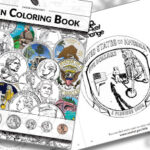
Fall Into History Resources
Monthly Mint Trivia: Which Mint building was nicknamed the “Granite Lady”?
History In Your Hands
 This fall, the Mint will reissue our nation’s first dollar coin, the 1794 Flowing Hair dollar, for its 230th anniversary. To mark this milestone, we share resources related to it and other landmark coins throughout American history. Read on for suggestions on how to incorporate these historic coins into your classroom.
This fall, the Mint will reissue our nation’s first dollar coin, the 1794 Flowing Hair dollar, for its 230th anniversary. To mark this milestone, we share resources related to it and other landmark coins throughout American history. Read on for suggestions on how to incorporate these historic coins into your classroom.
Explore historic coin learning ideas and resources from the U.S. Mint and around the web.
Flowing Hair Dollar (1794)
- Dollar Design Comparison: Watch the ‘What Do You Know About America’s First Coins?’ video (Grade 4+). Then pull up an image of the 1794 Flowing Hair dollar (this one is a copper test strike). Then pull up images or show real $1 coins from today. Examples include the Native American $1 coins or American Innovation $1 coins. Why have the people or objects on the coins stayed the same? Why have they changed? Ask students to note what words or symbols are used on each coin. What is the same? What is different? What clues can students use to tell if a coin is new or old?
- History of U.S. Coins (Grade 6+): This article includes a full history of circulating coins in the U.S., with many accompanying images. Ask students to read the article and select one coin to research. Ask students to investigate why the coin looks the way it does based on what they can find out about American history the year the coin was made.
Double Eagle $20 Gold Coin (early 20th century)
- Gold Rushes and Mint History (Grades 3+): In 1854, the San Francisco Mint opened and began producing coins to keep up with the gold rush. The most popular coin produced by the San Francisco Mint was the gold $20 coin, like this one. Read this article together so students can learn context around mining in the United States. Then, play the free game Gold Rush and see if students can make it as a gold prospector!
- Iconic Double Eagle Design (Grade 4+): Widely considered one of the most beautiful coin designs, the famous sculptor Augustus Saint Gaudens redesigned the Double Eagle in the early 1900s. Bring up this example from 1907 and make sure you zoom in. Ask students to look closely. What symbols and objects do they see? (examples: Capitol building, torch, stars, olive branch, eagle). How does this image of liberty look different than the Flowing Hair liberty from 1794?
Lincoln Penny (1909 to present)
- Lincoln Cent Design (Grade 4+): To honor Lincoln’s 100th birthday, the cent, or penny, produced in 1909 featured an image of him on the obverse (heads) side. Review the history of the cent and this design on the U.S. Mint Coin Classroom. Show students the obverse and reverse of the coin. Ask students to write down why Lincoln was an important person in American history. Then, discuss as a class how some of his accomplishments might appear in the symbols used on the coin over time (hint: the union shield on the back of the coin).
- Honoring Lincoln (Grade 8+): As explained in this history article, the public had mixed opinions when seeing these new the Lincoln cents. Allow students to review the linked article and other sources, like newspaper archives, to find accounts from when the coin was released. Why might some American’s not want to see Lincoln represented on their money? What event(s) during Lincoln’s lifetime were seen as controversial by some Americans? Which group(s) held strong opinions about this new coin design?
Buffalo Nickel (1907 to 1938)
- Distinct Imagery (Grade 6+): This famous coin features an American Indian on the obverse (heads) side and an American buffalo on the reverse (tails) side. Ask students to conduct some research using images of historic coins found on the Smithsonian collection. Ask them to investigate what makes this coin special. How many coins prior to 1907 featured animals besides the eagle? How many coins prior to 1907 featured American Indians? Why would these images be featured on coins during the early 1900s? What was happening in America during this time?
Historic Coin Designs in Games (Grade K+): Students can play several free online games and see some examples of historic coins and coin design elements throughout.
- Coin Flip Game and a coin flip activity (Grade 4+): Practice flipping coins to learn about probability.
- Coin Stamper Game (Grade 4+): Students will learn about different types of coins as they try to make the most money.
- Making Change (Grades K-3): Students can design and print out their own coin in this game.
Want more ideas? Reach out to education.outreach@usmint.treas.gov for recommendations on lesson plans and activities for your students.
Coin Parts Palooza
Play Coin Flip
Coin Making
We Want to Hear from You!
 Are you interested in incorporating coins into your classroom next year, but aren’t sure where to start? Let us help you! The U.S. Mint offers K-6 lesson plans, online educational games, videos, online quizzes, a free Coin Coloring Book, and other resources. Reach out to us at education.outreach@usmint.treas.gov to request resources that fit your education needs.
Are you interested in incorporating coins into your classroom next year, but aren’t sure where to start? Let us help you! The U.S. Mint offers K-6 lesson plans, online educational games, videos, online quizzes, a free Coin Coloring Book, and other resources. Reach out to us at education.outreach@usmint.treas.gov to request resources that fit your education needs.
Trivia Answer: The second San Francisco Mint building was nicknamed the “Granite Lady.”



